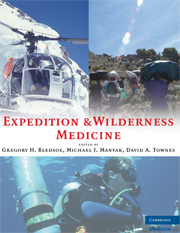Book contents
- Frontmatter
- Contents
- Contributors
- Foreword
- Preface
- Acknowledgments
- PART I EXPEDITION PLANNING
- PART II EXPEDITIONS IN UNIQUE ENVIRONMENTS
- 13 Tactical and Protective Medicine
- 14 Hostile Geopolitical Environments
- 15 Aerospace Medicine
- 16 Polar Medicine
- 17 Tropical Medicine for Expeditions
- 18 Subterranean Medicine
- 19 High-Altitude Medicine
- 20 Medicine at Sea
- 21 Event Medicine
- 22 Telemedicine in Evolution: Implications for Expeditionary Medicine
- 23 Dive Medicine
- PART III ILLNESS AND INJURIES ON EXPEDITIONS
- APPENDIX The Expedition Medical Kit
- Index
15 - Aerospace Medicine
from PART II - EXPEDITIONS IN UNIQUE ENVIRONMENTS
Published online by Cambridge University Press: 05 March 2013
- Frontmatter
- Contents
- Contributors
- Foreword
- Preface
- Acknowledgments
- PART I EXPEDITION PLANNING
- PART II EXPEDITIONS IN UNIQUE ENVIRONMENTS
- 13 Tactical and Protective Medicine
- 14 Hostile Geopolitical Environments
- 15 Aerospace Medicine
- 16 Polar Medicine
- 17 Tropical Medicine for Expeditions
- 18 Subterranean Medicine
- 19 High-Altitude Medicine
- 20 Medicine at Sea
- 21 Event Medicine
- 22 Telemedicine in Evolution: Implications for Expeditionary Medicine
- 23 Dive Medicine
- PART III ILLNESS AND INJURIES ON EXPEDITIONS
- APPENDIX The Expedition Medical Kit
- Index
Summary
INTRODUCTION
The American Board of Preventive Medicine states that “Aerospace medicine focuses on the clinical care, research, and operational support of the health, safety, and performance of crewmembers and passengers of air and space vehicles, together with the support personnel who assist operation of such vehicles.” From inception, aerospace medicine has been an archetypical example of the practice of medicine attending the exploration of an extreme environment. The many physical and physiological risks attending atmospheric and space flight mandated intimate medical involvement early on. Aerospace medicine evolved as a unique specialty, blending preventive and occupational medicine with clinical diagnostic and therapeutic practice in a population of individuals whose overall health is often excellent. The traditional physician–patient relationship is highly modified, of necessity. The flight surgeon must measure the health of aerospace crew and support personnel by job qualification standards, with potentially profound career impact. At the same time, responsibility to maintain the health of these individuals and to protect the safety of the public must remain paramount. This produces potential conflicts of interest – aerospace crew members may be hesitant to seek medical attention for fear of medical disqualification, and flight surgeons must act in the best interest of crew health and public safety, even when personal relationships and concerns may make decisions and actions difficult. The flight surgeon–aircrew relationship is the most complex physician–patient relationship in all of medicine and requires a great deal of maturity and sound judgment for successful outcomes.
- Type
- Chapter
- Information
- Expedition and Wilderness Medicine , pp. 184 - 196Publisher: Cambridge University PressPrint publication year: 2008



